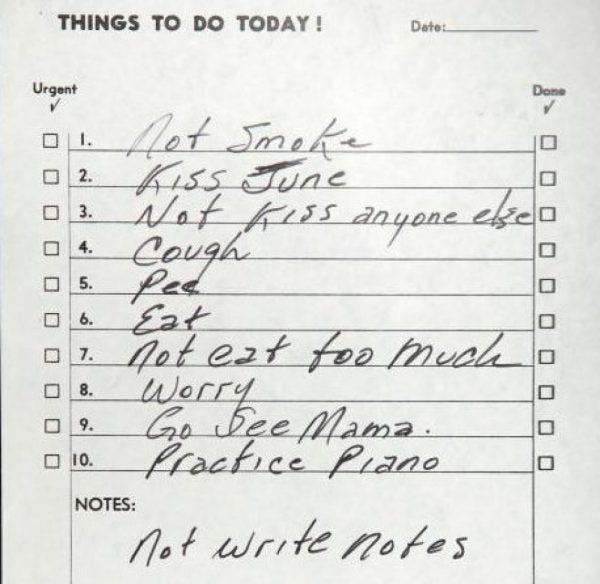Favours: if you haven’t got a copy of Timeboxing, consider getting one (links at bottom); if you’ve read and enjoyed the book, please leave a review on Amazon; and if all that’s too much effort, please just Heart this post, if you like it.
TLDR: Your to-do list is a work and life essential. There are many ways to improve it—here are some of the best.
Word count: 569
Read time: 3 mins
The to-do list is a tool almost everyone uses, very few get right, and many disparage.
To-do lists are personal. That’s why they’re so important to us. I suspect that’s also part of the reason people don’t talk about them all that much — you can’t share a to-do list even with colleagues as the view it gives of your internal thoughts and hopes…is just too raw. Johnny Cash’s famous to-do list (see image) is so famous because it’s funny but also because it’s a rare public example.
In researching Timeboxing, I scanned the literature and found much of what's written on the subject to be inane. It was shallow and obvious and mostly regurgitated.
There’s a stark lack of thought and an abundance of need on the topic of to-do lists. That’s why I dedicated a chapter (Chapter 10 — a 13-minute read) in the book.
It’s also why I created this infographic that got some attention on LinkedIn this week.
A to-do list is more than just a static record of tasks. You might think of it as a dynamic holding pen for ideas and priorities. How well you manage it determines whether will hinder or help your creativity, productivity and serenity.
People use to-do lists in different ways. Some prefer a trusty paper notebook, others check off boxes in apps, and some run multiple lists for work, home, or life admin. There’s no universal method, but there are ways to improve how you choose to do them.
Here are eight tips (also in the infographic) to make your to-do list work better for you:
Five feeds. Notice what feeds a to-do list. For me it’s ideas, messages, meetings, work and life in general. So be on the look-out in those contexts for any thought you may need to take action on later.
One digital list. I recommend keeping just one so there’s only one location you need to visit to see it all. Calibrating importance/urgency between lists is hard. And make that one place be a digital place so your list can be accessed from any device, wherever you are, and also it’s backed up to the cloud.
Aide-memoire. Don’t expect your brain to hold everything—offload tasks to your list and free up mental energy.
Use a verb to describe each task. This gives clarity on the action needed.
Break tasks down. I advocate 15-, 30- and 60-minute tasks and timeboxes. But in any case, do a little extra thinking to make the tasks less overwhelming and more manageable, so they actually get started… and actually get finished.
Keep it prioritised. Revisit your list regularly to make sure the more urgent and important items are at the top. If the list is long, chuck it into a spreadsheet, score each item 1-10 and sort on that scoring. Your list will immediately be in a much, much better state, and you may well be too.
Timebox it. Add vital items consciously, intentionally, into your calendar, so they become time-bound commitments rather than vague intentions.
Review and reflect. Take time to look over your to-do list, adjust priorities, and clear out completed or irrelevant tasks (timebox this too!)
And, of course, in combining your to-do list with your calendar, you’d be timeboxing. A structured calendar transforms a to-do list into a living system of organised, intentional actions.
In a way, a timeboxed calendar is like a giant done list with a little bit of to-do.
However you operate your to-do list today, consider how you might improve it. This is an important meta-task that will reap rewards every single day. So, how about adding it — right now — to your…
Marc
Links you may like
7 days of Timeboxing (the free email micro-course)
Timeboxing, the book (US)
Timeboxing, the book (UK)
Timeboxing, el libro (Español)
Connect with me on LinkedIn (I will say yes!)





There's lots of good advice here but I think that there is another, ultimately more fulfilling(?), way to sort out your Todo List. I describe it in a poem that I wrote last year titled 'Todo List':
https://andapoet.blog/2023/09/15/todo-list/